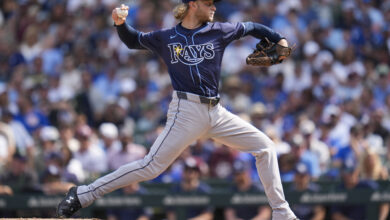Three Big Reasons Why the Cubs MUST Sign Aroldis Chapman
Let’s face it, every team that hopes to win the World Series absolutely must have a solid, if not elite, bullpen. In 2016, the Chicago Cubs traded away their number one prospect, Gleyber Torres, along with four other players to the New York Yankees for Aroldis Chapman. They then rode Chapman out of the bullpen, pitching him whenever the opportunity arose and that meant not just in the ninth inning, as Chapman was traditionally accustomed to.
In fact, as you’ll see in the chart below, Chapman was the centerpiece of the Cubs entire pitching strategy, throwing the fourth most innings of all the Cubs’ pitchers. And what the numbers below don’t show is how leveraged Chapman actually was when he entered the game. He inherited 11 runner’s in scoring position when he came into the game and prevented 55% of those runners (6) from scoring.
| G | W | L | SV | IP | H | R | ER | SO | ERA | ||
| 1 | Jon Lester | 6 | 3 | 1 | 0 | 35.2 | 27 | 9 | 8 | 30 | 2.02 |
| 2 | Kyle Hendricks | 5 | 1 | 1 | 0 | 25.1 | 19 | 5 | 4 | 19 | 1.42 |
| 3 | Jake Arrieta | 4 | 2 | 1 | 0 | 22.1 | 17 | 9 | 9 | 25 | 3.63 |
| 4 | Aroldis Chapman | 13 | 2 | 0 | 4 | 15.2 | 11 | 6 | 6 | 21 | 3.45 |
| 5 | Mike Montgomery | 11 | 1 | 1 | 1 | 14.1 | 14 | 5 | 5 | 11 | 3.14 |
| 6 | John Lackey | 3 | 0 | 1 | 0 | 13 | 14 | 8 | 7 | 12 | 4.85 |
| 7 | Travis Wood | 9 | 1 | 0 | 0 | 6.1 | 5 | 2 | 2 | 7 | 2.84 |
| 8 | Carl Edwards Jr. | 8 | 0 | 1 | 0 | 6.1 | 5 | 2 | 2 | 4 | 2.84 |
| 9 | Hector Rondón | 7 | 1 | 0 | 0 | 6 | 8 | 3 | 3 | 5 | 4.5 |
| 10 | Pedro Strop | 8 | 0 | 0 | 0 | 5.2 | 4 | 2 | 2 | 3 | 3.18 |
| 11 | Justin Grimm | 6 | 0 | 0 | 0 | 4.1 | 6 | 6 | 6 | 3 | 12.46 |
When you look at the numbers, there’s no question about how valuable Chapman was to the Cubs’ World Championship run. Here are three big reasons that the Cubs should, and arguably must, sign Chapman.
- He’s hands down the best closer in baseball. As a dominant left-handed, fire-ball throwing reliever, the Cubs had a weapon coming out of the bullpen that every single batter on the opposing team feared facing. The combination of his 104 MPH fastball and his diving slider are the most wicked tools you could possibly hope for in a late-inning reliever.
- His value is beyond just coming in to close the ninth inning. He proved in the playoffs that he’s willing to come into a game in high-leverage situations in any inning. In fact, out of his 13 games played in the 2016 postseason he entered the game earlier than the 9th inning in 7 of those games. And in the World Series, he did that 4 times of which the Cubs won all four games.
- No one wants to face Chapman in the postseason. I guess this one goes beyond saying but the significant point here is that the Cubs don’t want to have to face Chapman in the postseason. The difference between having Chapman on your team in the postseason compared to having to face Chapman in the postseason is enormous. The significance of this cannot be overstated.
When you look at the innings pitched for Cubs’ pitchers in the postseason, it’s very difficult to imagine who on the Cubs current roster would be able to step in to high leverage situations in the playoffs and be able to be relied on. To me, the only pitcher that could possibly fit is Carl Edwards, and that’s still a huge stretch and would leave a big hole in the Cubs bullpen, particularly if Hector Rondon and Pedro Strop don’t end up getting back to a point where they can be relied on.
If the Cubs don’t sign Chapman now they’re going to be left in the same position they were in during 2016, looking for a reliable closer they can ride to a World Series Championship. Why get to that position when they have the chance to sign Chapman and lock him in to a long term contract, thus addressing their closer role for the next several years, all years the Cubs will be in contention to not only get to, but win the World Series.

